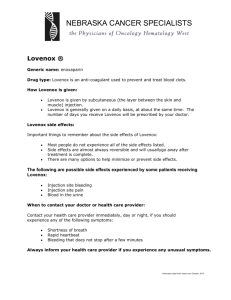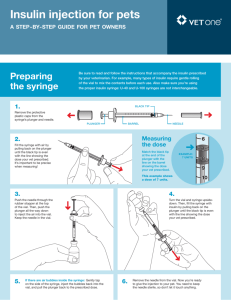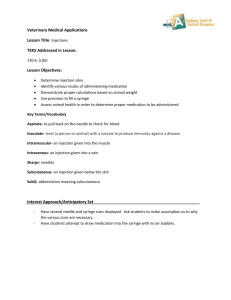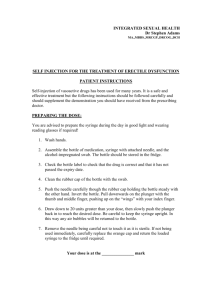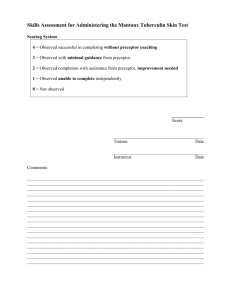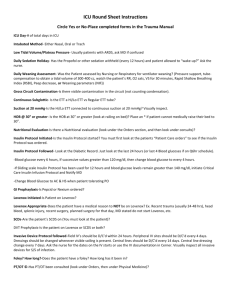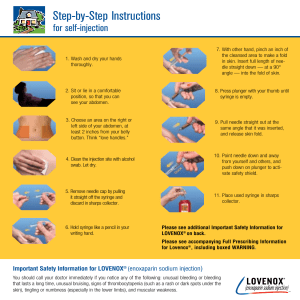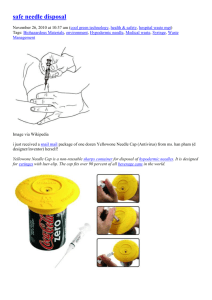Lovenox (Enoxaparin) Patient & Family Instructions
advertisement
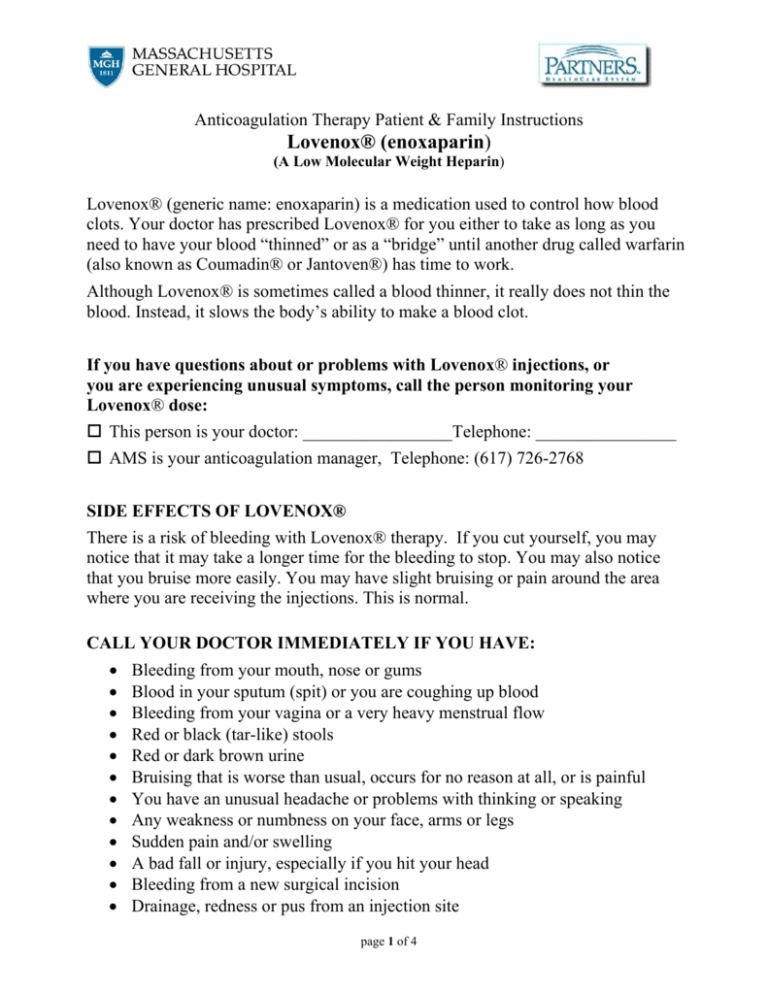
Anticoagulation Therapy Patient & Family Instructions Lovenox® (enoxaparin) (A Low Molecular Weight Heparin) Lovenox® (generic name: enoxaparin) is a medication used to control how blood clots. Your doctor has prescribed Lovenox® for you either to take as long as you need to have your blood “thinned” or as a “bridge” until another drug called warfarin (also known as Coumadin® or Jantoven®) has time to work. Although Lovenox® is sometimes called a blood thinner, it really does not thin the blood. Instead, it slows the body’s ability to make a blood clot. If you have questions about or problems with Lovenox® injections, or you are experiencing unusual symptoms, call the person monitoring your Lovenox® dose: This person is your doctor: _________________Telephone: ________________ AMS is your anticoagulation manager, Telephone: (617) 726-2768 SIDE EFFECTS OF LOVENOX® There is a risk of bleeding with Lovenox® therapy. If you cut yourself, you may notice that it may take a longer time for the bleeding to stop. You may also notice that you bruise more easily. You may have slight bruising or pain around the area where you are receiving the injections. This is normal. CALL YOUR DOCTOR IMMEDIATELY IF YOU HAVE: Bleeding from your mouth, nose or gums Blood in your sputum (spit) or you are coughing up blood Bleeding from your vagina or a very heavy menstrual flow Red or black (tar-like) stools Red or dark brown urine Bruising that is worse than usual, occurs for no reason at all, or is painful You have an unusual headache or problems with thinking or speaking Any weakness or numbness on your face, arms or legs Sudden pain and/or swelling A bad fall or injury, especially if you hit your head Bleeding from a new surgical incision Drainage, redness or pus from an injection site page 1 of 4 LOVENOX® INJECTIONS Lovenox® is only available in an injection form. The manufacturer supplies syringes that are color-coded based on the amount of Lovenox® in each syringe. It is injected once or twice a day and is usually started in the hospital. Your dose is based on your medical condition and how much you weigh. Some patients will need to expel a tiny amount of fluid (0.1 mL) from the syringe in order to inject the correct dose. Your Lovenox dose is: ________________ You have been supplied with a _______ mg syringe. The fluid level should be at the _______ mark on the syringe to provide the dose ordered by your physician. Inject the entire amount from the syringes provided, do NOT expel anything. It is safe to inject the air bubble as you do not want to loose any of the drug. Do NOT inject the entire amount in the syringes provided. Your physician has prescribed less than a full syringe. Expel 0.1 ml of fluid from the syringes provided. Follow these steps to do this: Hold syringe like a pencil. Remove the needle cap. Do not push on plunger. -Turn the syringe needle pointing up. Be sure air bubble is at the top. If no air bubble, tap the syringe with your finger. Gently and slowly push the plunger to expel the air bubble and amount of medication you were instructed to remove. Use the plunger as the guide to remove the correct amount of fluid. If any fluid is on the needle, tap or shake the syringe to remove any excess but do not touch the needle. Pull back on the syringe just enough to replace the air bubble. This ensures that the correct dose will be completely administered in the injection. Proceed with giving the injection. See instructions: How to Give a Subcutaneous Injection. Once the injection is done and needle is removed, point the needle away from you and down. Firmly push on the plunger to activate the needle shield. The shield covers the needle. The syringe can now be disposed of as instructed. page 2 of 4 HOW AND WHEN TO TAKE LOVENOX® Lovenox® is given by injection just under the skin (called a sub-Q or subcutaneous injection). To avoid loss of drug, do not expel air bubbles from the pre-filled syringe before injection. To minimize injection site bruising, rotate where the shots are given. Acceptable sites are: the U-shaped area below and at least 2 inches away from belly button. If you have help: left or right outer sides of the buttocks. Occasionally, if needed, the upper and outer sides of the left or right thigh can be used. At home, you, a family member or a visiting nurse will inject the drug. Do not rub the site after injecting. Your injections should occur at about the same time every day. Store your Lovenox® syringes at room temperature. Keep the syringes away from heat and direct light. Do NOT use the syringes after the expiration date. Keep syringes safely out of reach of children. IF YOU FORGET TO TAKE YOUR LOVENOX® If you remember within 3 hours of your scheduled time – inject the dose and continue on your normal schedule. If you remember 3 hours or more after your scheduled time – call your doctor or the AMS. If you do not hear back from your doctor or the AMS before your next scheduled dose, inject the dose and continue on your normal schedule. Your doctor or the AMS may change your dosing schedule. MONITORING Patients taking Lovenox® should have a complete blood count and kidney function tests done before starting and as needed after that. If you also take warfarin, you will need additional blood tests. When the warfarin is working properly, your doctor or the AMS staff will let you know that you can stop the injections. SPECIAL DIETS We recommend that you eat a healthy balanced diet, a special diet is not needed. If allowed by your doctor, limit your alcohol intake to no more than two standard drinks a day. page 3 of 4 IMPORTANT FACTS TO KNOW WHEN TAKING LOVENOX® Take only the drugs that your doctor has prescribed. If you see another doctor or dentist, tell them you are taking Lovenox® . When filling a new prescription, always ask the pharmacist to make certain that it is safe to take the new medication with Lovenox® . DO NOT take any over-the-counter medicines, herbal products or dietary supplements unless you have asked your doctor first. DO NOT take aspirin, ibuprofen (Advil® or Motrin®), naproxen (Aleve®) or similar products unless prescribed by your doctor. Always check the labels of over-the-counter drugs for aspirin (also called ASA, or acetylsalicylic acid). Many pain relievers and cold medicines (like AlkaSeltzer® or Pepto Bismol™) have aspirin in them. You may take aspirin free pain relievers like acetaminophen (Tylenol®). Please carry some form of drug alert identification while taking Lovenox® . LOVENOX® AND PREGNANCY/BREAST-FEEDING Let your doctor know if you are pregnant or plan to become pregnant. Lovenox® should be used during pregnancy only if clearly needed. Let your doctor know if you are breast-feeding. It is not known if Lovenox® affects a mother’s milk and should be used with caution. Note: Please contact Lynn Oertel for questions about this instructional material. 08/24/2006, rev 4/2009 page 4 of 4 Anticoagulation Therapy Patient & Family Instructions How to Give a Subcutaneous Injection for Lovenox®, Fragmin® or Fondaparinux® SUPPLIES Pre-filled syringe(s) of prescribed medication Alcohol pad to wipe the skin Sharps container PREPARING TO GIVE THE SHOT Wash your hands with soap and water. Dry your hands. Sit or lie in a comfortable position so you can easily see the area where you will be injecting. Select an injection site. The injection must be given subcutaneously (under the skin) in the fatty tissue. DO NOT inject in the same place each time. Alternate the site from the left and right sides. If you’ve had surgery, avoid areas close to surgical incisions or bandages. The best areas for injections are: Abdomen: A U-shaped area below the navel (belly button) area. Keep at least 2 inches away from belly button. If additional injection sites are needed, consider: Legs: The upper and outer sides of left or right thigh (stay away from the inner part of the thigh). Buttocks: If another person can give the injection: the upper and outer part of the buttocks. If another person can give the injection: the left or right sides of the back abdominal wall. page 1 of 4 HOW TO GIVE A SHOT (the instructions below are specific to Lovenox® brand low molecular weight heparin and the needle guard system for this type of syringe. Different injectable anticoagulants have slightly different needle guard systems. Refer to product information for more details or ask your pharmacist or nurse.) Wipe the injection site with an alcohol swab. Allow the area to dry. While the area is drying, remove the needle shield from the syringe. The syringe is pre-filled and ready to go. Do not remove the air bubble in the syringe. DO NOT press on plunger before injecting. Gently pull up a “fold of skin” at the injection site to hold the fat tissue away from the muscle. Hold the syringe like a pencil. The needle can be inserted at an angle of 45° or 90°. Be sure to hold skin fold throughout injection. Quickly push the needle into the injection site. Be sure the needle is all the way in. Push the plunger in at a steady rate. Push the plunger all the way down to inject full amount. Pull the needle straight out quickly. Hold the alcohol wipe over the injection site. Do NOT rub the area. page 2 of 4 Turn the needle away from you and others. Activate the safety system by firmly pushing the plunger rod. The protective sleeve will automatically cover the needle and you will hear a soft “click” to confirm shield activation See information below to safely dispose of the syringe. Write down the date and time the shot was given as well as the dose and site of the shot on the Medication Shot Record. (see next page) PROPER DISPOSAL OF NEEDLES AND SYRINGES Place used needles and syringes into a safe “sharps” container. Examples: Coffee can or hard plastic bottle, such as an empty bleach or liquid detergent bottle with lid. Do NOT use a container that will be returned to a store or recycled. Do NOT use glass or clear plastic containers. Seal the lid with heavy-duty tape, like duct tape, when the container is full. Check with your local community waste disposal agency for the right way to dispose of the container. Keep needles and syringes out of the reach of children. Note: Please contact Lynn Oertel, CNS for questions about this instructional material, 4/2009 page 3 of 4 Medication Shot Record Name of medication to be injected: _________________________________ Dose and time(s) of day for injection: _______________________________ Date Time Dose page 4 of 4 Site
